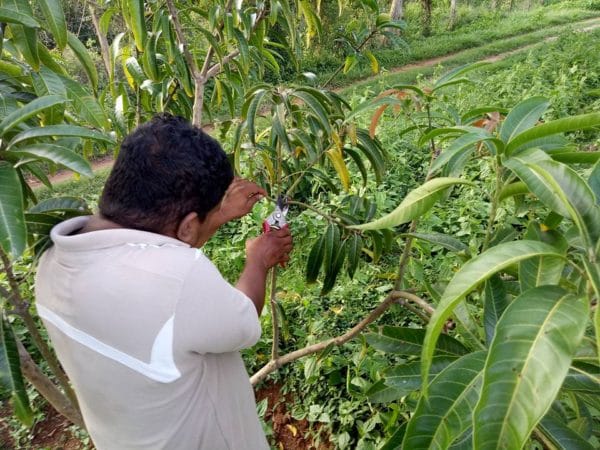12 Reasons For Pruning Fruit Trees For Amazing Results

Pruning fruit trees is one of those ongoing maintenance tasks that can scare a lot of new gardeners. Although it can often times be critical for a thriving fruit tree, it really doesn’t need to be that imposing. Fruit trees can be quite forgiving and will bounce back if you prune too much or make a cut that you regret. No, you won’t be hurting the tree, but rather helping it become a thriving fruit tree for years to come.
Why do you need to prune a fruit tree? Pruning a fruit tree creates a healthy tree that will have a structure for maximum fruit yield. By minimizing disease, allowing for proper sunlight, and strong branch structure, an annually pruned fruit tree is a necessity for fruit tree owners.
Help them Get Established
If you purchased your fruit tree bare root, meaning it was shipped without soil during dormancy, it’s important to give the tree an initial hard cut. I recommend cutting the tree down to about 2 feet, as long as it was grafted near the base of the tree.
Bare root or not, when buying a standard 3-gallon tree, making this initial cut can be a beneficial method to get your tree started. This helps the tree get established by starting with more roots then top growth. Having a strong root foundation is critical for a stout tree.
Many times some of the roots are severed when removed bare root or the nursery is focused on getting a lot of top growth to entice buyers. A lot of the roots that have been severed are feeder roots or surface roots that take in nutrients. This method is referred to as “pugging” and you can read my in-depth post: Pug Fruit Trees to Keep Them Small.
Sunlight
Light is paramount for producing high-quality fruit and healthy growth. We get plenty of sunlight here in the Arizona desert, sometimes too much. Our fruit tends to be higher in brix or the amounts of sugar, due to the ample sun.
Opening up the center of a fruit tree is a standard method of pruning, commonly known as pruning to an open vase, in order to allow sunlight into all parts of the tree. Some fruit trees grow with a central leader or main upright trunk, which should be pruned for light.
Overcrowding or dominant branches should be removed so the canopy is balanced. The fruit is going to develop properly and produce the highest amounts of sugar with proper sunlight.
Disease Prevention
As you prune, you’ll occasionally find dead branches or branches that may have been exposed to fungal or bacterial disease. Pruning off these types of branches can help minimize the spread of disease throughout your tree or further dieback. Make sure you always sterilize your pruning shears with rubbing alcohol before pruning other trees.
Air Flow
Allowing for adequate air flow through the tree is going to aid in the health of the tree. When trees are allowed to grow densely, it’s more common for high winds to snap limbs or even uproot the tree. Proper air flow can help alleviate fungal build-up from too much humidity as well.
Holding Fruit
Sometimes you can get those vigorous branches that just shoot out, but are pretty flimsy. Pruning these types of branches back can aid in building stronger branches. Fruit can be heavy so it is important to have branches that can withstand the weight of the fruit.
Pruning can help build that structure needed for fruit support. Otherwise, half your crop may end up on the ground with broken branches. Not to mention when limbs break it exposes the tree to potential disease, pests, and stress.
Manageable Size
A tree left to grow unpruned can get quite large. Do you want to feed your family or the birds? A 25-foot tree just puts the fruit way out of human reach. You’ll need to resort to climbing up a large ladder or using a large picker to pull the fruit. I’d much rather keep the tree at a smaller size to be able to have fruit within arm’s reach for an easy harvest.
High Density Planting
This practice falls in line with keeping fruit trees a manageable size. For those gardeners in an urban setting, we aren’t blessed to have acres of land to plant orchards of fruit trees. We have to maximize our ability to grow fruit trees on a small scale.
High-density planting methods consist of diligent pruning methods to keep fruit trees smaller in order to pack more trees in tight spaces. Doing things like planting multiple trees in a planting hole are high-density planting strategies that can only be accomplished through pruning.
I highly recommend checking out some of the videos by Dave Wilson Nursery. Here is one:
Crossing Branches
Branches have a way of growing every direction. Sometimes they will overlap each other, crowd each other, or cross over one another. Removing branches that cross helps the tree to maintain that air flow and prevent limbs from damaging one another.
Production
Research has shown that pruning helps with overall fruit production for most fruit trees. Some fruit trees produce on old wood and some will only produce on new growth. These are things to consider when pruning.
Looks Good
The last thing you want is a tree with unruly growth and branches all over the place. Creating a symmetrical look helps to enhance the beauty of the yard and garden. It increases the value of your property when the yard is looking at its best. Properly pruned fruit trees will make it that more enjoyable to sit out and enjoy the view of your backyard creation.
Remove Safety Concerns
If trees are allowed to get too large, sometimes they can encroach upon things like power lines or structures that pose safety concerns. Large limbs can snap and cause damage to property or people that may be nearby. If you have kids you know that they love climbing trees, let’s make sure that the tree is in good shape to prevent any potential falls. It’s also good courtesy to prevent the tree from overgrowing into neighbor’s yards.
Promote New Growth
When you cut a branch back it usually sends new growth shoots out of the node or nodes just below the cut. This is good for creating new growth or to encourage branching. A lot of times, more branches means more fruit production.
Final Thoughts
Pruning a fruit tree doesn’t have to be a daunting event. When you consider the importance of pruning, it’ll help with knowing that it’s just a part of the gig. Not only does pruning not adversely affect your fruit trees, nor do you have to worry about harming the tree when pruning, it’s going to help your fruit tree become a healthy, happy, productive tree.
Please comment below on anything that you’ve enjoyed from this post or related to pruning fruit trees.

My husband and I have some peach trees in our backyard, so I wanted some maintenance tips. I didn’t know you can prune your tree to open it up to sunlight, so your fruit develops properly. I’ll have to call a tree service that can come prune my trees when I’m busy and still learning to prune them the right way, thanks to this post!